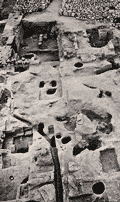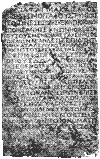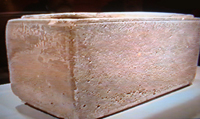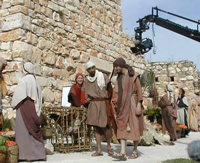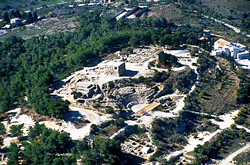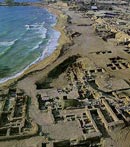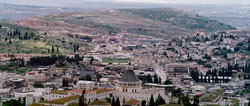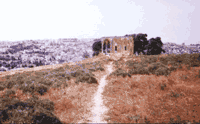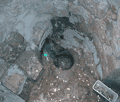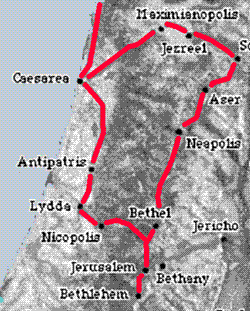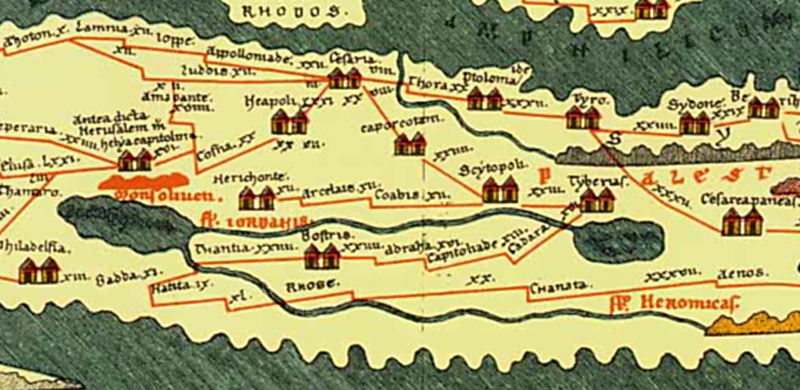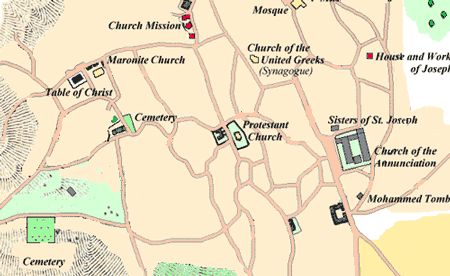
He who has ears
Let him hear!
No Nazareth – No Jesus! 5-minute enlightenment
for those in a hurry
Good for Business
"Nazareth has many wonderful sights ... Our facilities can accommodate visitors and conventioneers alike ... an outstanding destination for visitors from all over the world ..."
– Mayor of the City of Nazareth
The 1955/68 Excavation at Nazareth – storage pits & votive lamps – enough for Franciscan archaeologists to declare Nazareth 'the village of Jesus, Mary & Joseph' and the site of 'uninterrupted veneration' by Christians.
Road to Nowhere
"Contrary to assertion, there is no evidence of a major road extending from Sepphoris through Nazareth, and on to Jerusalem. The evidence for an interregional Roman road from Sepphoris to Jerusalem through the central hill country and past Nazareth is late or post-Hadrianic and dates after the Bar Kochba Revolt."
– Jonathan L. Reed, Archaeology and the Galilean Jesus: A Re-examination of the Evidence, p117.
The Archaeological Record:
Late and Middle Stone Age periods.
13 human skeletons and many artifacts unearthed in a cave at Mount of Precipice.
Middle-late Bronze (2000-1200 BC)
Remains of pottery from three tombs.
No non-funerary remains.
Iron (1200-586 BC)-- Some of these less numerous finds may be funerary, and some not. They come from caves in the vicinity of the Church of the Annunciation.
They were found in various 'silos' (cavities in the ground) and 'from other places' (unspecified) nearby. These remains include 5 vases, as well as jugs and jars (mostly fragments).
Babylonian and Persian periods (586-332 BC)
– No finds.
Hellenistic and Hasmonaean periods (332-37 BC)
-- No finds.
Roman I (Herodian, 37 BC- 70 AD)The remains from this period possibly include 6-10 oil lamps. (But they may date as late as 150 AD).
Of these, 4 are from Tomb 70 (near the Church of the Annunciation), 2 were found under the Church's 'grottos', and 4 are from nearby places.All are originally from tombs – consistent with the provenance of most of the surviving oil lamps of this period throughout Palestine.
Roman II (70-180 AD)4 lamps from two tombs (Tomb 70, and a tomb 250 m. south of Church of the Annunciation).
Roman III (180-324 AD)Seven lamps from the same two tombs as above.
From a late-Roman building, some plastered stones, remnants of a mosaiced floor, and a Roman coin of the mid-4th century.Pottery and other 'movable' evidence (glass, etc.) – the preponderance from 3rd & 4th centuries AD, and some from 2nd century AD.
The 7 lamps all come from one and the same tomb (No. 70).
They were not spread out over an area suggesting the multiple locations associated with a 'village'.
Nor were they in domestic use at the time of their placement in situ – they are all funerary votive lamps.
Misusing the evidence
"The growing archaeological evidence unearthed in and around Galilee is, unfortunately, only taken into consideration in an ad hoc manner, to bolster claims about the historical Jesus or to illustrate a point about his Galilean background."
– Jonathan L. Reed, Archaeology and the Galilean Jesus: A Re-examination of the Evidence, p103.
Coins Found ...
'Some Jewish coins, or at least some pieces having Old Hebrew characters, much defaced ...'
G. Schumacher (1889 Palestine Exploration Fund, Quarterly Statement)
Cavemen?
"Grotto No, 25: In the area of the medieval church we find a flight of stairs cut in he rock, as that in front of the granary No. 48, and then a threshold of a door with the west jamb still in situ and the other fallen ..."– Father Bagatti
The cave dwellings discovered in the 'village' could have been used by later squatters.
"The Nazareth Decree"
Edict of an unnamed Caesar warns of trial and death penalty for desecration of tombs. (Louvre)
Provenance of the slab is unknown (it was sent from the town of Nazareth in 1878 but could have been found anywhere) and is typical of decrees issued throughout the imperial period.
Nothing links the slab with Christianity let alone the godman – though determined apologists insist it confirms the Resurrection!
Locals fix a miracle for the tourists
"At Nazareth the Jewish community even organised the famous bench miracle for credulous Christian pilgrims.
Visitors to Nazareth, reported the pilgrim of Piacenza, were shown the book in which Christ printed his alphabet and the bench on which he used to sit with other children.
Local Jews affected not to be able to move the bench, though Christians, as if by a miracle, moved it about without difficulty."
– R. Gordon, Holy Land, Holy City, p 93.
Christmas Special - another Christian Theme Park Attraction
A deplorable modern Christian tradition is to call an attention-grabbing press conference in the days before the Christmas holiday. The intent is to garner maximum publicity for some sensational "Jesus discovery".
In 2009 it was a "Jesus-era house", located conveniently close to the Church of the Annunciation.
The finds that captured the international headlines in December, were uncovered months earlier and more prosaically reported as "two rock-cuttings in the bedrock and the remains of a large building dated to the Mamluk period."
By the holiday, they had become "the first house from the time of Jesus", and a hidden pit, interpreted as "Jewish preparations for the impending war with Rome".
Hey, something for Christians and Jews!
The fact that the archaeologist, Yardenna Alexandre – involved at "Mary's Well" in 1998 – was sponsored by the Nazareth Municipality and the Israeli Tourist Board, clearly had no influence on her gushing "breaking news". Nor was it pertinent that the site was within a new international Christian centre being funded by French Roman Catholics.
What, stoop to the level of cheap sensationalism to keep the circus on the road?
"Brother of Jesus bone box"
In 2002 it was the purported "James brother of Jesus" ossuary that for a time was hailed by the world's press as the "first evidence of Jesus". It was subsequently exposed as a forgery.
"Jesus bathhouse"
In the late 1990s a Christian gift shop owner discovered an Ottoman bathhouse below his shop near Mary's Well. Subsequently, parts of the site were re-dated to the Crusader period, and by 2003 certain worthies were ready to declare that the find was "a bathhouse from the time of Jesus".
Of course, the Romans occupied Palestine for several hundred years so the identification with Jesus is a tad tenuous!
But if you want to contribute a few dollars to the "continuing work" and the owner's plans to turn the site into a "nice, small 'boutique' hotel" here's the link.
Faking it
"Faith you can hear, see, touch, taste, & embrace!"
For those who don't care whether their history is authentic or manufactured in the 21st century, the Nazareth Village theme park brings you the faith-building experience.
If you have your credit card handy you can support the scam right now.
Glory!
René Salm's
Nazareth myth site
Theology First ...
'It may then come as something of a surprise, almost an embarrassment, to recognise that the earliest statements about Jesus are in the form of belief rather than history in the modern sense ... theology takes precedence over history in the Christian story.'
– J. L. Houlden (Jesus - A Question of Identity, p11)
The
Lost City The Gospels tell us that Jesus's home town was the 'City of Nazareth' ('polis Natzoree'):
However when we look for historical confirmation of this hometown of a god – surprise, surprise! – no other source confirms that the place even existed in the 1st century AD.
Sepphoris – an ersatz Nazareth?
Downsizing In short order, Christian apologists fall over themselves to explain, 'But of course, no one had heard of Nazareth, we're talking of a REALLY small place.' By semantic downsizing, city becomes TOWN, town becomes VILLAGE, and village becomes 'OBSCURE HAMLET'. Yet if we are speaking of such an obscure hamlet the 'Jesus of Nazareth' story begins to fall apart. For example, the whole 'rejection in his homeland' story requires at a minimum a synagogue in which the godman can 'blaspheme.' Where was the synagogue in this tiny bucolic hamlet? Why was it not obvious to the first pilgrims like Helena (see below) – it would, after all, have been far more pertinent to her hero than a well? In reality, such a small, rustic community could never have afforded its own holy scrolls, let alone a dedicated building to house them. As peasant farmers almost certainly they would have been illiterate to a man. If JC had grown up and spent thirty years of his life in a village with as few as 25 families – an inbred clan of less than 300 people – the 'multitude' that were supposedly shocked by his blasphemy and would have thrown him from a cliff, would not have been hostile strangers but, to a man, would have been relatives and friends that he had grown up with, including his own brothers. Presumably, they had heard his pious utterances for years. Moreover, if the chosen virgin really had had an annunciation of messiah-birthing from an angel the whole clan would have known about it inside ten minutes. Just to remind them, surely they should also have known of the 'Jerusalem incident' (Luke 2.42-49) when supposedly the 12-year-old proclaimed his messiahship? Indeed, had no one mentioned what had happened in Bethlehem – star, wise men, shepherds, infant-massacre and all? Why would they have been outraged by anything the godman said or did? Had they forgotten a god was growing up in their midst? And what had happened to that gift of gold – had it not made the 'holy family' rich? If Nazareth really had been barely a hamlet, lost in the hills of Galilee, would not the appellation 'Jesus of Nazareth' have invoked the response 'Jesus of WHERE?' The predictable apologetic of quoting gospel John ("Can anything good come out of Nazareth?" - 1.46) implies that the questioner, Nathanael, had indeed "heard of" the vanishing small hamlet (Nathanael was supposedly a local boy from Cana). But would anyone outside of Galilee have recognized the name? Then again, if Nazareth had really been a tiny hamlet, the nearest convenient 'mountain' from which the god-man could have been thrown – a cliff edge (Luke 4.28-30) – would have been 4 km away, requiring an energetic climb over limestone crags. Would the superman really have been frog-marched so far before 'passing through the midst of them' and making his escape? Of course, all these incongruities exist because the 'Jerusalem incident' and the whole nativity sequence were late additions to the basic messiah-in-residence story. Be that as it may, was there even a tiny village? The archaeological evidence? The world has been blessed by the fact that excavation at Nazareth has been conducted by Catholic archaeologists. In an earlier age they may well have "found" sandals neatly inscribed with "property of Jesus Christ". As it is, they diligently extract every last drop of sanctity from some pretty meagre findings. Yet for all their creative interpretations even the Franciscans cannot disguise the fact that the lack of evidence for a pre-Jesus village at the Nazareth site is virtually total. Not that the Franciscans have lacked the opportunity to find what they want to find; they have, in fact, been in Palestine for several centuries, official custodians of the 'Holy Land' as a result of Papal Bulls 'Gratias agimus' and 'Nuper charissimae' issued by Clement VI in 1342. During the Crusaders' wars, Nazareth had changed hands several times. At one point (1099) the Norman-Sicilian adventurer Tancred had set up a 'principality of Galilee' with Nazareth as his capital. But the Christians were repeatedly kicked out until finally, in 1263, Nazareth was completely devastated by Sultan Baibars and the whole area left desolate for nearly 400 years. The Franciscans got back into the area under a deal with Fakhr ad-Din II, emir of Lebanon, in 1620. They reoccupied the remains of the crusader fort but found Greek monks still in possession of 'Mary's Well' . With funds flowing in they took over the town administration and in 1730 built a church over the Grotto. The demolition of this structure in 1955 paved the way for 'professional' archaeology, and the 'discovery' of the Biblical Nazareth in the very grounds of the Church itself!
With a great leap of faith the partisan diggers declared what they had found was 'the village of Jesus, Mary & Joseph' – though they had not found a village at all, and certainly no evidence of particular individuals. The finds were consistent, in fact, with isolated horticultural activity, close to a necropolis of long-usage. Rather conveniently for the Catholic Church, questionable graffiti also indicated that the shrine was dedicated to the Virgin Mary, no less! Yet one point is inescapable: the Jewish disposition towards the 'uncleanliness' of the dead. The Jews, according to their customs, would not build a village in the immediate vicinity of tombs and vice versa. Tombs would have to be outside any village.
An archaeological survey of the surface of the land adjacent to Nazareth Hospital was conducted between February and May 1997 by Pfann and a team, all from the Center for the Study of Early Christianity. Two distinct areas were identified which are defined by the type of terracing found there. Yet dating by traditional stratification was not possible. With typical Christian zeal Pfann was able to conclude that 'Nazareth was tiny, with two or three clans living in 35 homes spread over 2.5 hectares'. It was just unfortunate that all evidence of the homes was razed by later invaders. In truth, the scanty evidence is consistent with the site being used as a single family farm over many centuries – and a single family farm does not make a village. Excavations by Michael Avi-Yonah at Caesarea in 1962:
History and archaeology actually begin to coincide with the discovery of a fragment of dark gray marble at a synagogue in Caesarea Maritima in August 1962. Dating from the late 3rd or early 4th century the stone bears the first mention of Nazareth in a non-Christian text. It names Nazareth as one of the places in Galilee where the priestly families of Judea migrated after the disastrous Hadrianic war of 135 AD. Such groups would only settle in towns without gentile inhabitants, which ruled out nearby Sepphoris. Apparently, the priests had been divided from ancient times into twenty-four 'courses' that took weekly turns in Temple service. The restored inscription reads:
One might speculate that Christian control of the village's sole water source eventually drove the perfidious Jews away, thus allowing the Greek monks to take over the 2nd century synagogue – now known as the 'synagogue-church' – sometime in the 4th century when Christianity got the official stamp of approval. A town grew up at the site, causing the abandonment and destruction of any more ancient Jewish dwellings which, as in Capernaum, were most probably built without foundations. Some Jews subsequently re-settled in the valley, for we know that they were expelled again from the area in the 7th century for collaboration with the Persians.
Getting a Name The expression 'Jesus of Nazareth' is actually a bad translation of the original Greek 'Jesous o Nazoraios' (see below). More accurately, we should speak of 'Jesus the Nazarene' where Nazarene has a meaning quite unrelated to a place name. But just what is that meaning and how did it get applied to a small village? The highly ambiguous Hebrew root of the name is NZR. The 2nd century gnostic Gospel of Philip offers this explanation:
It was the later Gospel of Matthew which started the deceit that the title 'Jesus the Nazorene' should in some manner relate to Nazareth, by quoting 'prophecy':
So how did the village get its name? It seems that, along with the Nozerim, a related Jewish/Christian faction, the Evyonim – ‘the Poor’ (later to be called Ebionites) – emerged about the same time. According to Epiphanius (Bishop of Salamis , Cyprus, circa 370 AD) they arose from within the Nazarenes. They differed doctrinally from the original group in rejecting Paul and were 'Jews who pay honour to Christ as a just man...' They too, it seems, had their own prototype version of Matthew – ‘The Gospel to the Hebrews’. A name these sectaries chose for themselves was 'Keepers of the Covenant', in Hebrew Nozrei haBrit, whence Nosrim or Nazarene! In other words, when it came to the crunch, the original Nazarenes split into two: those who tried to re-position themselves within the general tenets of Judaism ('Evyonim'-Nosrim); and those who rejected Judaism ('Christian'-Nosrim) Now, we know that a group of 'priestly' families resettled an area in the Nazareth valley after their defeat in the Bar Kochbar War of 135 AD (see above). It seems highly probable that they were Evyonim-Nosrim and named their village 'Nazareth' or the village of 'The Poor' either because of self-pity or because doctrinally they made a virtue out of their poverty.
Dodgy Story, Dodgy Geography The original gospel writers refrained from inventing a childhood, youth or early manhood for JC because it was not necessary to their central drama of a dying/reborn sun-god. But as we know, the story grew with the telling, particularly as the decades passed and the promised redeemer and judge failed to reappear. The re-writer of the Gospel of Mark, revising the text sometime between 140 and 150 AD, introduced the name of the city only once, in chapter one, with these words:
Clearly, "Jesus the Nazarene" in the original tale became "Jesus, a resident of Nazareth" in the updated story of Matthew and Luke. Indeed, there are indications that an early layer in the development of Mark favoured Capernaum as the hometown of Jesus (home of the six most prominent disciples, venue for several key miracles, etc.). We can trace the subsequent elevation of Nazareth in the Gospel of Luke. Luke is the writer who emphasizes JC's ties to 'Nazareth.' Luke is the writer who goes out of his way to demonstrate an anti-Capernaum stance. Scholars have concluded Luke was not a Jew himself because of his 'glaring errors in things Jewish'. He also makes mistakes in his geography. He knows little about the place and in his mini-drama describes an impossible incident:
The Town that Theology Built In the 3rd century Church Father Origen knew the gospel story of the city of Nazareth – yet had no clear idea where it was – even though he lived at Caesarea, barely thirty miles from the present town! Even in Origen's day, as the Church became more institutionalised, intense rivalry was developing between the patriarchs of Caesarea and Jerusalem. This rivalry was only resolved (in Jerusalem's favour) at Chalcedon in 451. Part of the rivalry centred on control of 'Holy places'. Hence, 'finding' the lost city of Nazareth was a matter of major importance, Perambulating to the rescue, in the early 4th century, came the 80-year-old dowager Empress Helena. Preparing the way for an imminent meeting with her maker with a program of 'Works', she made a conscience-salving pilgrimage to Palestine. In the area of Nazareth she could find nothing but an ancient well – in fact the only water source in the area (which in itself demolishes the idea there was ever a 'city' ). No doubt encouraged by canny locals, Helena promptly labelled the hole in the ground 'Mary's Well' and had a small basilica built over the spot. Conveniently, the gospels had failed to make clear exactly where Mary had been when the archangel Gabriel had come calling. Thus the Well site acquired local support for the divine visitation and Nazareth acquired its first church. Helena
created the pilgrimage business which has never ceased. Yet before the passage of the imperial grandee, not a single ancient source had established a precise location for the 'Nazara' of the gospels.
4th Century Pilgrim Route – and NO NAZARETH!
A generation after the dowager empress had gone touring, another geriatric grandee, the Lady Egeria, spent years in the 'Land becoming more Holy by the day'. Egeria – a Spaniard, like the then Emperor Theodosius and almost certainly part of the imperial entourage – reached the Nazareth area in 383. This time, canny monks showed her a 'big and very splendid cave' and gave the assurance that this was where Mary had lived. The Custodians of the Cave, not to be outbid by the Keepers of the Well, insisted that the cave, not the well, had been the site of the divine visitation. This so-called 'grotto' became another pilgrimage attraction, over which – by 570 – rose the basilica of another church. Today, above and about the Venerable Grotto, stands the biggest Christian theme park in the Middle East.
4th Century Roman Map – and NO NAZARETH!
The Levantine coast from the so-called Peutinger map or "table" (Tabula Peutingeriana), with west to the top. The complete map is twenty-two feet wide and is so-named for Conrad Peutinger, a 16th century German antiquarian and is currently held in Vienna. The map is actually a medieval copy (12th or 13th century) of a 4th century Roman original (it shows Constantinople, founded in the year 328). The whole world known to the Romans is represented, from Spain in the west to India in the east. In the section shown here, below the city of Aelia Capitolina (centre left), the map shows one site which had by this stage entered the Christian dreamscape – the Mount of Olives (red). The cartographer of this unique record named more than 3000 places. And guess what? – he does not mention Nazareth!
By the late 4th century – by which time the Church had control of theological correctness – Nazareth was being correctly described by Jerome as 'a very small village in Galilee' (Onom. 141:3). He should know: he had fled scandal in Italy to set up an ecclesiastical retreat in the area for well-heeled Romans. The village owed its very existence to the imperial itinerary half a century before. By the 5th century the supposed site of Nazareth – marked by its couple of churches – had become a key destination for pious (and leisured) pilgrims. We know of a Piacenza visiting in 570, of an Arculf visiting in 638, a Wilhebald in 724, an Al Mas'udi in 943. Sewulf in 1102, like the earlier visitors, reported that only the annunciation church was to be seen. In 636 Arab armies overran Byzantine possessions in Palestine, including Nazareth. A Christian presence continued in the area, though it was subject to restrictions and heavy taxes. Nearly five centuries later, Crusaders occupied the valley and built a fort. On the foundations of the earlier Byzantine 'grotto' church they built something a little grander, more befitting their resident bishop.
Today more than a million visitors (fifty per cent of tourists visiting Israel) call at Nazareth. Who would want to spoil the party? So perhaps keep it quiet ... The evidence for a 1st century town of Nazareth does not exist – not literary, not archaeological, and not historical. It is an imaginary city for an imaginary god-man.
Nazareth App You could find out more about the city of Nazareth and it's historical significance by downloading this android app play store link
Sources:
|
|||||||||||||||||||||||||||||||||||||||||||||||||||||||||||||||||||||||||
Enlighten a friend e-mail this page
Copyright © 2004
by Kenneth Humphreys.
Copying is freely permitted, provided credit is given to the author and
no material
herein is sold for profit.
